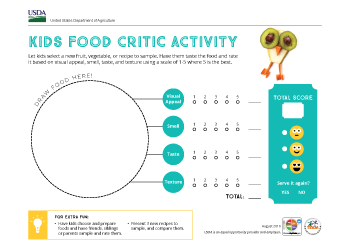|
This is the new and improved online claiming service from Minute Menu. And best of all Kidkare will work on all browsers on any platform!
Check out Kidkare at https://app.kidkare.com/#/login/ by using your same login and password that has been provided to you from Child Care Development Services. Everyone will need to make the change by September 2017. Kidkare will have the updated meal pattern guidelines and replace Minute Menu. Minute Menu will not support the new meal patterns and guidelines. Get a head start and make the change today. If you need assistance call your coordinator at his/her phone number or the receptionist at 503-489-2528 or check out the great training tutorials @ https://help.kidkare.com/help
0 Comments
, when the Academy of Nutrition and Dietetics reminds everyone to return to the basics of healthy eating. It is also the time of year when the Academy celebrates expertise of registered dietitian nutritionists as the food and nutrition experts.
What is cool, creamy and delicious? Yogurt! Even better, it is a great part of a healthy diet for kids. Yogurt is rich in protein and calcium and contains potassium. One cup counts as one of the three dairy servings recommended for children 9 years old through adulthood by USDA's MyPlate. For 2- and 3-year-olds, two cups of dairy is recommended and 2½ cups for 4- to 8-year-olds. Yogurt can also contain live, active bacteria cultures, as indicated on the label. These cultures, or probiotics, are considered "good bacteria" for the gut and can help maintain healthy digestive systems. Yogurt comes in an array of flavors and styles. On a single trip to the supermarket, a shopper could easily see more than a dozen different brands with at least three varieties of each for sale. Between low-fat, fat-free, fruited, flavored, plain, Greek and traditional — the choices can be overwhelming. Here is a breakdown to help you select what's best for you and your family. Whole Milk, Low-Fat or Fat-Free? Overall, it is best to choose low-fat or fat-free yogurt as recommended by the Dietary Guidelines and MyPlate. There are many delicious low-fat and fat-free options to choose from. Fruited, Flavored or Plain? Added sugar is a common ingredient in fruited and flavored varieties of yogurt. Skip the added sugars by choosing plain yogurt and adding your own fruit or flavors such as cinnamon and vanilla. You should note that when you read the Nutrition Facts label on plain yogurt, you still will see that it lists "sugar" even though no sugar has been added. This is because even plain yogurt contains lactose, the naturally occurring sugar in milk. In 2016, the FDA announced updates to the Nutrition Facts label. The new labels will make it easier for consumers to know the added sugars in packaged foods. Greek Yogurt or Traditional Yogurt? Greek yogurt is strained. This process makes it thicker, creamier and smoother than traditional yogurt. It also has double the protein of traditional yogurt, but reduced calcium. In both traditional and Greek yogurts, bacteria cultures help break down lactose, so yogurt is sometimes an easier dairy food to digest for those who are lactose intolerant. Greek yogurt has less lactose than traditional yogurt, so lactose-sensitive individuals may tolerate it even better than traditional yogurt. Whether low-fat or fat-free, Greek or traditional, there are many ways to enjoy yogurt. Try these easy breakfast, snack or dessert ideas with your family:
Check out our training on Tofu and be prepared for the meal pattern changes.
Keep kids energized and satisfied with this delicious, healthy wrap made with beans and veggies.
Ingredients6 8-inch Whole wheat tortillas 1 1/2 cups Prepared hummus 1 cup Red bell pepper (cut into 1/4-inch strips) 1/2 cup Carrots, grated 1 1/2 cups Baby spinach leavesDirections1. Place the 6 tortillas on a clean surface. 2. Place 1/4 cup of hummus in the center of each tortilla. Use a butter knife to spread the hummus evenly from side to side across the center of the tortilla. 3. Top the hummus with 4-6 red pepper strips and 1/4 cup grated carrots. 4. Divide the spinach leaves evenly between each tortilla, arranging the leaves over the top of the vegetables. 5. Fold the bottom edge of the tortilla up and over the vegetables, and then continue rolling up to the top edge. 6. Cut each wrap diagonally across the center width of the wrap. 7. Place both halves on a plate to serve. Notes
Meal Pattern Contribution Statement Legume as Meat Alternate: 1 wrap provides 1.25 oz eq meat alternate, 3/8 cup red/orange vegetable, 1/8 cup other vegetable and 1.75 oz eq grains. OR Legumes as Vegetable: 1 wrap provides 1/4 cup legume vegetable, 3/8 cup red/orange vegetable, 1/8 cup other vegetable and 1.75 oz eq grains. Legume vegetable can be counted as either a meat alternate or as a legume vegetable but not as both simultaneously. Source: Summer Food, Summer Moves (FNS-607) Kids are much more likely to try new foods when they get to take the lead. In this fun game, kids get to pick a new food at the grocery store, taste it, and rate it like a food critic. Find more Activities @ Team Nutrition
|
CCDS Staff
Serving Oregon child care providers since 1977 Archives
February 2019
Categories |
||||||
Telephone
|
|





 RSS Feed
RSS Feed